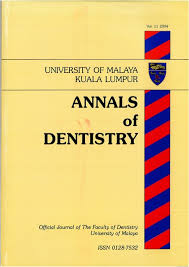Assessment of Knowledge Regarding Furcation Defects among Dental Practitioners: A Multinational Survey
DOI:
https://doi.org/10.22452/adum.vol30.1Keywords:
Dentists, Furcation DefectsAbstract
This study was undertaken to assess knowledge regarding furcation defects among dental fraternity. This is an open-ended, randomized, web-based cross-sectional multinational online survey. A total of 904 responses were gathered by sending 13 questions through a google form. Data were expressed in frequency and percentages. Chi-square test was performed to determine significant difference between gender, education level and variation between dentists of India and other countries. P value <0.05 was considered to be statistically significant. Present study had 650 dentists from India and 254 dentists from other countries. For overall knowledge regarding furcation, 90.7% (average of first and second question) of dentists had knowledge regarding furcation. There was no significant difference between males (range 54%-93%) and females (range 46%- 95%) (p>0.05) in terms of knowledge. Majority (88.7%) of post-graduates knew about the use of Nabers probe for furcation measurements and values were significant (p<0.05). Present study also revealed 65%-67% of undergraduates and post-graduates knew that Degree II furcation defects showed predictable periodontal regeneration, however values were non-significant (p>0.05). There was no statistical significance (p>0.05) between dentists of India and other countries. Dental fraternity in general had adequate knowledge regarding the furcation defects, their treatment modalities and expected complications.
Downloads
References
Trevethan R. Deconstructing and assessing knowledge and awareness in public health research. Front Public Health. 2017;5:194-200.
Nagrik AP, Bhagat BA, Yemle SB, Maidapwad S. Awareness of specialties of dentistry among medical trainees and teaching faculty of medical college in the Central West India. J Int Soc of Prev Community Dent. 2019;9(3):269-74.
Kornman KS, Giannobile WV, Duff GW. Quo vadis: what is the future of periodontics? How will we get there? Periodontol. 2000 2017;75(1):353-71.
Pilloni A, Rojas MA. Furcation involvement classification: a comprehensive review and a new system proposal. Dent J. 2018;6(3):34-46.
Goh EX, Ong MM. Anatomical, microbiological, and genetic considerations in treatment of Chinese periodontal patients. J Investig Clin Dent. 2019;10(1):e12381-e12390.
Walter C, Weiger R, Zitzmann NU. Periodontal surgery in furcation-involved maxillary molars revisited—an introduction of guidelines for comprehensive treatment. Clin Oral Investig. 2011;15(1):9-20.
Gonçalves BC, Costa ALF, Correa R, Andere NMRB, Ogawa CM, Santamaria MP, de Castro Lopes SLP. Analysis of geometrical tomographic parameters of furcation lesions in periodontitis patients. Heliyon. 2021;7(1):e06119-e06128.
Avila‐Ortiz G, De Buitrago JG, Reddy MS. Periodontal regeneration–furcation defects: a systematic review from the AAP Regeneration Workshop. J Periodontol 2015;86:S108-S130.
Agarwal A, Manjunath RS, Sethi P, Shankar GS. Platelet-rich fibrin in combination with decalcified freeze-dried bone allograft for the management of mandibular degree II furcation defect: A randomised controlled clinical trial. Singapore Dent J. 2019;39(1):33-40.
Jepsen S, Gennai S, Hirschfeld J, Kalemaj Z, Buti J, Graziani F. Regenerative surgical treatment of furcation defects: A systematic review and Bayesian network meta‐analysis of randomized clinical trials. J Clin Periodontol. 2020;47(S22):352-74.
Könönen E, Gursoy M, Gursoy UK. Periodontitis: A multifaceted disease of tooth-supporting tissues. J Clin Med. 2019;8(8):1135-47.
Abdulbaqi HR, Abdulkareem AA, Alshami ML, Milward MR. The oral health and periodontal diseases awareness and knowledge in the Iraqi population: Online‐based survey. Clin Exp Dent Res. 2020;6(5):519-28.
Siaili M, Chatzopoulou D, Gillam D. An overview of periodontal regenerative procedures for the general dental practitioner. Saudi Dent J. 2018;30(1):26-37.
Hamp SE, Nyman S, Lindhe J. Periodontal treatment of multi rooted teeth. Results after 5 years. J Clin Periodontol. 1975;2(3):126-35.
Parihar AS, Katoch V. Furcation involvement & its treatment: a review. J Adv Med Dent Scie Res. 2015;3(1):81-7.
Rasperini G, Majzoub J, Tavelli L, Limiroli E, Katayama A, Barootchi S, Hill R, Wang HL. Management of Furcation-Involved Molars: Recommendation for Treatment and Regeneration. Int J Periodontics Restorative Dent. 2020;40(4):e137-e146.
Sathyamurthy P, Padhye A, Gupta HS. Knowledge of diagnosis, treatment strategies, and opinions on periodontal treatment procedures among general dentists in an Indian urban population: A questionnaire survey. J Indian Assoc Public Health Dent. 2018;16(1):62-71.
Karthikeyan BV, Sujatha V, Prabhuji M. Furcation measurements: realities and limitations. J Int Acad Periodontol. 2015;17(4):103-15.
Panda S, Karanxha L, Goker F, Satpathy A, Taschieri S, Francetti L, Das AC, Kumar M, Panda S, Fabbro MD. Autologous platelet concentrates in treatment of furcation defects—A systematic review and meta-analysis. Int J Mol Sci. 2019;20(6):1347-64.
Chen TH, Tu YK, Yen CC, Lu HK. A systematic review and meta-analysis of guided tissue regeneration/osseous grafting for the treatment of Class II furcation defects. J Dent Sci. 2013;8(3):209-24.
Reddy MS, Aichelmann-Reidy ME, Avila-Ortiz G, Klokkevold PR, Murphy KG, Rosen PS, Schallhorn RG, Sculean A, Wang HL Periodontal regeneration—furcation defects: practical applications from the AAP regeneration workshop. Clin Adv Periodontics. 2015;5(1):30-9.
Bowers GM, Schallhorn RG, McClain PK, Morrison GM, Morgan R, Reynolds MA. Factors influencing the outcome of regenerative therapy in mandibular Class II furcations: Part I. J Periodontol. 2003;74(9):1255-68.
Downloads
Published
Issue
Section
License
Copyright (c) 2023 Annals of Dentistry University of Malaya

This work is licensed under a Creative Commons Attribution 4.0 International License.
- The Faculty of Dentistry, Universiti Malaya holds the copyright of the published manuscript including all its components such as supplementary information, graphical contents and raw data without any restrictions.
- The author grant the Faculty of Dentistry, University of Malaya assignable and sub-licensable right, unlimited in time and territory, to copy-edit, reproduce, publish, distribute, transmit, make available and store the Article, including abstracts thereof, in all forms of media of expression now known or developed in the future, including pre- and reprints, translations, photographic reproductions and extensions.
- After acceptance for publication in Ann Dent UM, the author(s) have the right to use any of its components in whole or in part for academic purposes such as, presentation in scientific conferences and seminars.


